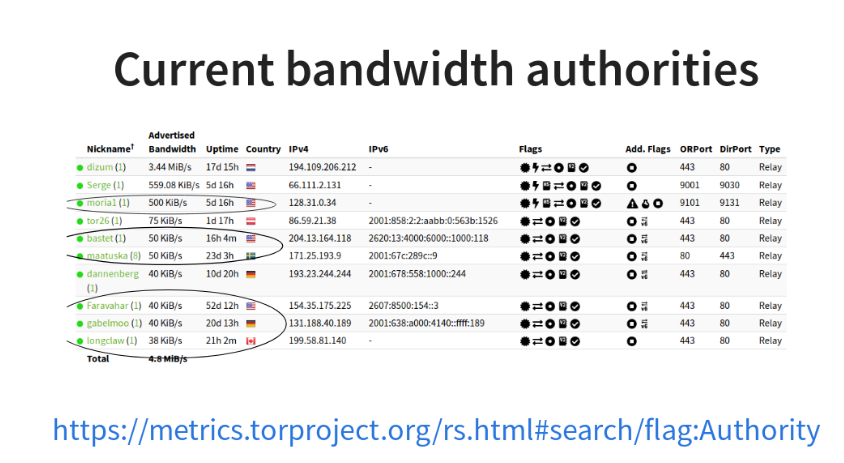How sbws works¶
Overview¶
The scanner measures the bandwidth of each relay in the Tor network (except the directory authorities) by creating a two hops circuit with the relay. It then measures the bandwidth by downloading data from a destination Web Server and stores the measurements.
The generator read the measurements, aggregates, filters and scales them using torflow’s scaling method.
Then it generates a bandwidth list file that is read by a directory authority to report relays’ bandwidth in its vote.

Initialization¶
Parse the command line arguments and configuration files.
Launch a Tor thread with an specific configuration or connect to a running Tor daemon that is running with a suitable configuration.
Obtain the list of relays in the Tor network from the Tor consensus and descriptor documents.
Read and parse the old bandwidth measurements stored in the file system.
Select a subset of the relays to be measured next, ordered by:
relays not measured.
measurements age.
Classes used in the initialization:
Source code: sbws.core.scanner.run_speedtest()
Measuring relays¶
For every relay:
Select a second relay to build a Tor circuit.
Build the circuit.
- If
bwscanner_cc=2: do HTTPS POST requests to the Web server over the circuit.
- else:
do HTTPS HEAD and GET requests to the Web server over the circuit.
- If
Store the time the request took and the amount of bytes uploaded or dowlodaded.
Source code: sbws.core.scanner.measure_relay()
Source code: sbws.core.scanner.upload_data()
Measuring a relay¶
Source code: sbws.core.scanner.measure_relay()
Selecting a second relay¶
If the consensus has cc_alg=2 param, use the exits that have 2 in the field FlowCtrl in their proto line, otherwise
If the relay to measure is an exit, use it as an exit and obtain the non-exits.
If the relay to measure is not an exit, use it as first hop and obtain the exits.
From non-exits or exits, select one randomly from the ones that have double consensus bandwidth than the relay to measure.
If there are no relays that satisfy this, lower the required bandwidth.
Source code: sbws.core.scanner.measure_relay()
Selecting the data to download¶
While the downloaded data is smaller than 1GB or the number of download is minor than 5:
Randomly, select a 16MiB range.
If it takes less than 5 seconds, select a bigger range and don’t keep any information.
If it takes more than 10 seconds, select an smaller range and don’t keep any information.
Store the number of bytes downloaded and the time it took.
Source code: sbws.core.scanner._should_keep_result()
Selecting the data size to upload¶
It’s computed in similar fashion to the download but using a bytes generator.
Source code: sbws.core.scanner.upload_data()
Writing the measurements to the filesystem¶
For every measured relay, the measurement result is put in a queue. There’s an independent thread getting measurements from the queue every second. Every new measurement is appended to a file as a json line (but the file itself is not json!). The file is named with the current date. Every day a new file is created.
Source code: sbws.lib.resultdump.ResultDump.enter()
C-tor client stream bandwidth limitation¶
Because the way circuits work in C-tor, the stream bandwidth upper limit is around 11MB/s.
See also